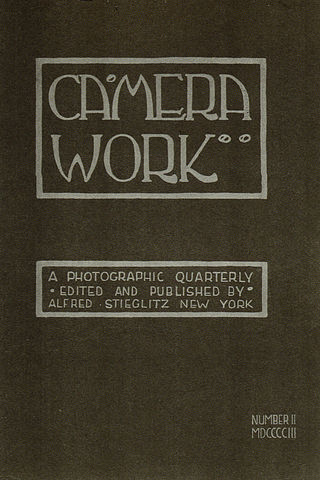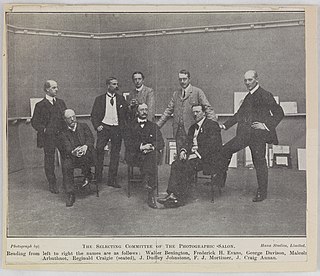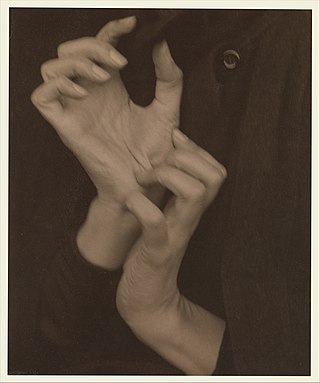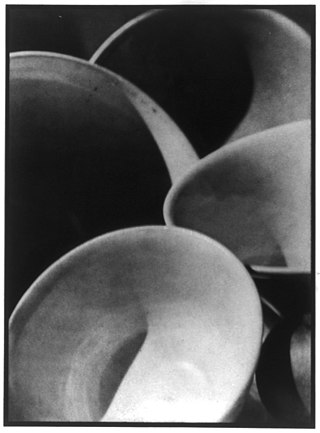
Pictorialism is an international style and aesthetic movement that dominated photography during the later 19th and early 20th centuries. There is no standard definition of the term, but in general it refers to a style in which the photographer has somehow manipulated what would otherwise be a straightforward photograph as a means of creating an image rather than simply recording it. Typically, a pictorial photograph appears to lack a sharp focus, is printed in one or more colors other than black-and-white and may have visible brush strokes or other manipulation of the surface. For the pictorialist, a photograph, like a painting, drawing or engraving, was a way of projecting an emotional intent into the viewer's realm of imagination.

Alfred Stieglitz was an American photographer and modern art promoter who was instrumental over his 50-year career in making photography an accepted art form. In addition to his photography, Stieglitz was known for the New York art galleries that he ran in the early part of the 20th century, where he introduced many avant-garde European artists to the U.S. He was married to painter Georgia O'Keeffe.
291 is the commonly known name for an internationally famous art gallery that was located in Midtown Manhattan at 291 Fifth Avenue in New York City from 1905 to 1917. Originally called the "Little Galleries of the Photo-Secession", the gallery was established and managed by photographer Alfred Stieglitz.

Camera Work was a quarterly photographic journal published by Alfred Stieglitz from 1903 to 1917. It presented high-quality photogravures by some of the most important photographers in the world, with the goal to establish photography as a fine art. It has been called "consummately intellectual", "by far the most beautiful of all photographic magazines", and "a portrait of an age [in which] the artistic sensibility of the nineteenth century was transformed into the artistic awareness of the present day."

Alice Boughton was an early 20th-century American photographer known for her photographs of many literary and theatrical figures of her time. She was a Fellow of Alfred Stieglitz's Photo-Secession, a circle of photographers whose artistic efforts succeeded in raising photography to a fine art form.

The Linked Ring was a British photographic society created to propose and defend photography as being just as much an art as it was a science. Members dedicated to the craft looked for new techniques that would cause the less knowledgeable to steer away, persuading photographers and enthusiasts to experiment with chemical processes, printing techniques and new styles.

The Steerage is a black and white photograph taken by Alfred Stieglitz in 1907. It has been hailed as one of the greatest photographs of all time because it captures in a single image both a formative document of its time and one of the first works of artistic modernism.
There were men and women and children on the lower deck of the steerage. There was a narrow stairway leading to the upper deck of the steerage, a small deck right on the bow with the steamer.
To the left was an inclining funnel and from the upper steerage deck there was fastened a gangway bridge that was glistening in its freshly painted state. It was rather long, white, and during the trip remained untouched by anyone.
On the upper deck, looking over the railing, there was a young man with a straw hat. The shape of the hat was round. He was watching the men and women and children on the lower steerage deck...A round straw hat, the funnel leaning left, the stairway leaning right, the white drawbridge with its railing made of circular chains – white suspenders crossing on the back of a man in the steerage below, round shapes of iron machinery, a mast cutting into the sky, making a triangular shape...I saw shapes related to each other. I was inspired by a picture of shapes and underlying that the feeling I had about life."

Equivalents is a series of photographs of clouds taken by Alfred Stieglitz from 1925 to 1934. They are generally recognized as the first photographs intended to free the subject matter from literal interpretation, and, as such, are some of the first completely abstract photographic works of art.

Rudolf Eickemeyer Jr. was an American pictorialist photographer, active in the late 19th and early 20th centuries. He was one of the first Americans to be admitted to the Linked Ring, and his photographs won dozens of medals at exhibitions around the world in the 1890s and early 1900s. He was famous among his contemporaries for his portraits of high-society women, most notably model and singer Evelyn Nesbit. Eickemeyer's best-known photographs are now part of the collections of the Smithsonian Institution.

The Terminal is a black and white photograph taken by Alfred Stieglitz in 1893. The photograph was taken in New York using the small 4 x 5 camera, which was a more practical instrument to document the city life than the 8 x 10 view camera, who could only work with a tripod.

Spring Showers, the Coach is a black and white photograph taken by Alfred Stieglitz in 1899–1900. The picture was published in the Camera Notes journal in January 1902. Sometimes it is incorrectly presented as being taken in 1902.

From the Back Window - 291 is a black and white photograph taken by Alfred Stieglitz in 1915. The picture was taken at night from a back window of his 291 gallery in New York. Its one of the several that he took that year from that window, including at a snowy Winter.
Untitled Film Still 48 is a black and white photograph taken by Cindy Sherman in 1979. It is part of her Untitled Film Stills photographic series, taken from 1977 to 1980. This picture is also known as The Hitchhiker.

Georgia O'Keeffe - Hands, also known as Georgia O'Keeffe (Hands), is a black and white photograph taken by Alfred Stieglitz in 1919. It is part of a large group of more than 300 photographs that he took of the painter Georgia O'Keeffe, from 1917 prior to their 1924 marriage, through 1937.

Georgia O'Keeffe - Torso, also known as Georgia O'Keeffe - Nude, is a black and white photograph taken by Alfred Stieglitz in 1918. It is one of the more than 300 photographs that he took of his future wife, the painter Georgia O'Keeffe.

The Hand of Man is a black and white photograph taken by Alfred Stieglitz in 1902. This is one of the pictures he took concerning urban life and would be published in the first issue of his magazine Camera Work, in January 1903. A note on this issue stated that “The Hand of Man.. is an attempt to treat pictorially a subject which enters so much into our daily lives that we are apt to lose sight of the pictorial possibilities of the commonplace.”

Clearing Winter Storm, Yosemite National Park, California is a black and white photograph taken by Ansel Adams, c. 1937. It is part of a series of natural landscapes photographs that Adams took from Inspiration Point, at Yosemite Valley, since the 1930s.

Abstraction, Porch Shadows, also known as Abstraction, Porch Shadows, Twin Lakes, Connecticut, is a black and white photograph taken by Paul Strand in 1916. It is one of the best known photographs of his early phase, and shows the influence of cubism and abstractionism. It is considered one of the first abstract photographs ever made.

Bowls, also known as Abstraction, Bowls, is a black and white photograph taken by Paul Strand in 1916. The photograph has elements of cubism and abstractionism, and exemplifies his style at the time.

The Flatiron is a coloured photograph made by American photographer Edward Steichen in 1904. Its one of the best known photographs of his pictorialist phase. The photograph was part of the "International Exhibition of Pictorial Photography", held in the Albright Art Gallery, in Buffalo, in 1910.


















